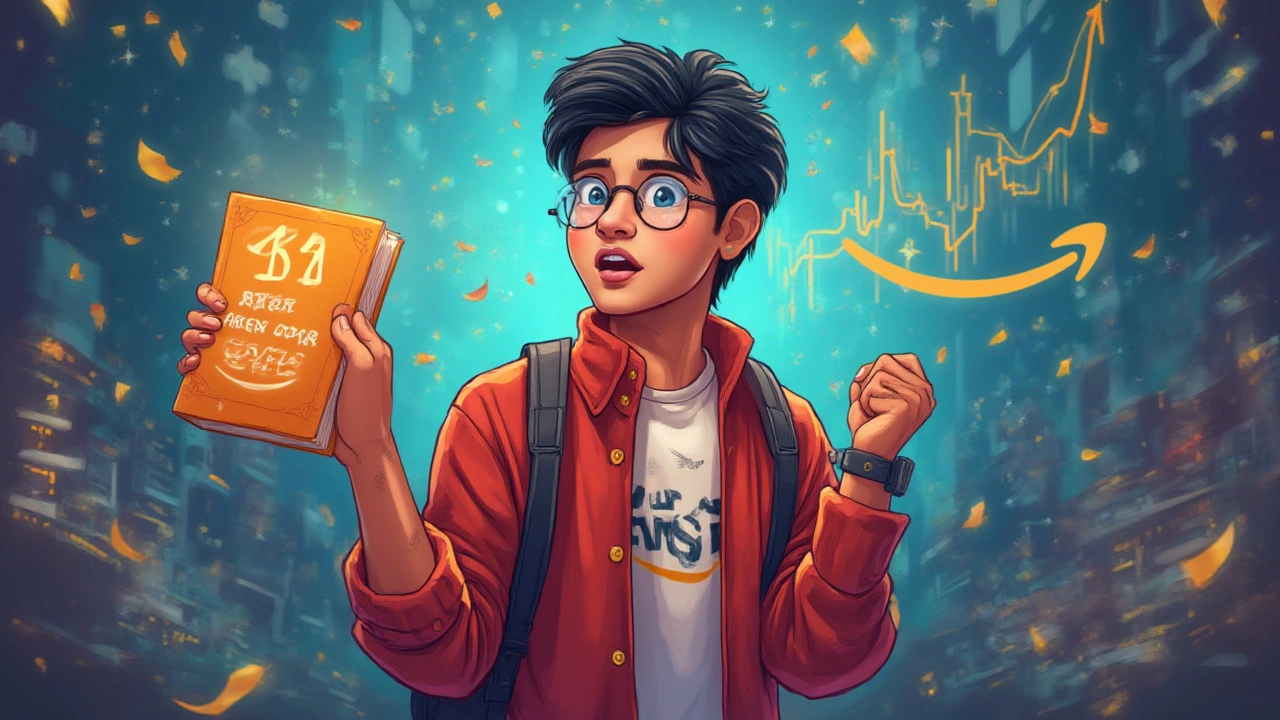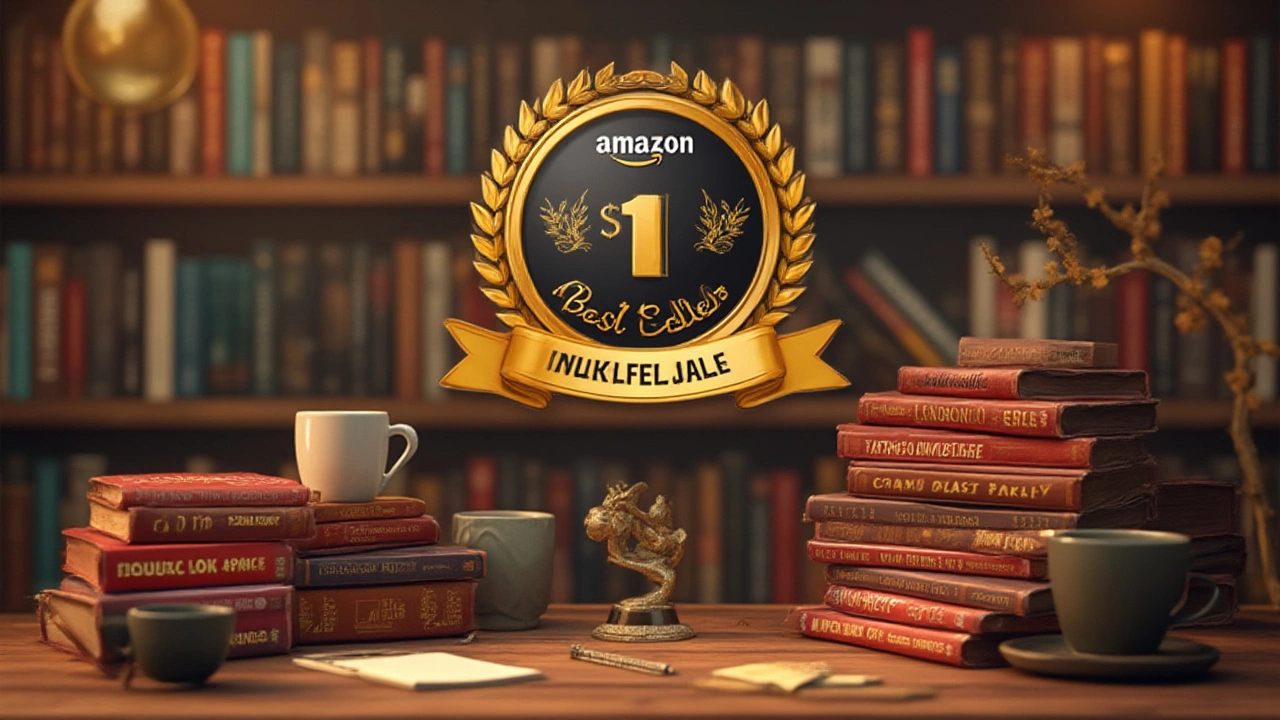What Makes an Amazon #1 Best Seller? Explaining the Bestseller Tag
 Jul, 27 2025
Jul, 27 2025
Walk into any bookshop, scroll through posts on social media, or even chat with aspiring authors you meet in Bristol’s cafes, and you’ll hear the phrase: 'Amazon #1 Best Seller.' It looks impressive. It sounds like the title of someone who’s just swept the globe. But here’s what most people never tell you—there’s a whole lot more to becoming an Amazon #1 best seller than you might think, and it’s not always what you imagine.
How Amazon Decides What’s #1
This might surprise you, but the secret to being an Amazon #1 best seller often isn’t about selling truckloads of books around the world overnight. Amazon’s world-famous best seller badge is tied to rankings, and those rankings are changing constantly—sometimes as fast as every hour. Amazon uses an algorithm (yes, more mysterious math) that considers current sales of a book in a particular category and how those sales stack up against others at that exact moment. So, a children’s book that suddenly spikes in sales thanks to a morning TV mention could outrank a perennial best seller for a brief window—and snag that orange #1 badge.
Categories are absolutely the game here. Amazon has a mind-boggling number of book categories and subcategories—some are wide like ‘Mystery & Thriller,’ and some are so narrow you’ve probably never noticed them until you click 10 times into a menu. If you’re top of, say, 'Puppy Training for Beginners,' even for an hour, you’re an Amazon #1 best seller in that category. That means timing, tactics, and even a bit of luck can play a big part—sales figures and competition within a category can be vastly different. In broader categories, you may need thousands of sales a day to reach the top; in a niche, maybe less than a dozen gets you the crown.
Want to see how it all shakes out? Have a glance at this table showing estimated minimum sales required per day to hit #1 in certain categories (based on rough online studies and author feedback):
| Category | Daily Sales Needed for #1 |
|---|---|
| Kindle Store (All) | Over 3,000 |
| Romance (Main Category) | 1,000+ |
| Self-Help (Small Subcategory) | 5-50 |
| Children’s Books (Niche Subcategory) | 2-20 |
Keep in mind, these are ballpark figures and change every day, but it explains why some books can truthfully advertise they were an Amazon #1 best seller—sometimes for just a fleeting moment, and sometimes with surprisingly few sales. The important takeaway here? The system is dynamic, a bit unpredictable, and totally dependent on context.
What Does the Best Seller Badge Really Mean?
You’ve likely seen bestseller badges while browsing. The ‘#1 Best Seller’ badge on Amazon is orange, almost hard to miss. It can appear next to a book if it’s currently ranked as the top seller in any single category or subcategory. This badge disappears as soon as the sales tumble or someone else outsells you. It’s a bit like a crown passed around—a book can wear it for days, hours, or occasionally just for minutes.
This raises a pretty hefty question: is every book with a #1 badge a massive mainstream sensation? Not exactly. The badge is all about being first in a specific race—not the whole marathon. You could have a runaway hit in 'Financial Engineering for Kids,' while the global number one in the Kindle Store at the moment is the latest celebrity memoir. Both are 'Amazon #1 Best Sellers'—just not in quite the same way.
The best seller tag can give a real boost to sales when people spot it. Best seller badges function almost like little trust stickers—they stand out, especially in a crowded market. Some readers do use them to decide which books are worth clicking on. Publishers (and authors who self-publish) have picked up on this, and it’s now a strategy to try to land that badge during launch week (or even just launch day). Books might launch in smaller, less-competitive subcategories to grab badges fast, then advertise their triumph in the bio. Ever seen a book claim it’s a ‘#1 Best Seller in Travel Guides to Yorkshire & The Humber’? That’s the game.
There’s also a difference between badges. The orange ‘#1 Best Seller’ is entirely based on real-time ranking, as discussed. Amazon also uses a similar ‘Best Seller’ icon for books leading their categories. But the real prize, the one that carries enduring prestige in traditional publishing, is making the New York Times Best Seller list. Amazon's badge is algorithm-driven and fast-moving, while the NYT list reflects sales over a week, based on more than just Amazon’s metrics.
Another wrinkle? Some authors and marketing firms have manipulated the system in the past. It’s happened: coordinated bulk buys during launch hours, encouraging fans to buy all at once, or even steering a book into obscure subcategories. No law is broken, but it makes the whole territory a bit foggy for anyone looking for the next great read based on a badge alone.

How Authors and Publishers Aim for the Top Spot
If you’ve ever seen self-published authors cheering about their badge on Twitter (well, X now) or Instagram, you’re glimpsing the behind-the-scenes work. Launching a book on Amazon is much more tactical than you might expect. It’s all about positioning—where the book lands in the vast Amazon labyrinth can make all the difference. Many authors lean hard into niche subcategories because they increase the odds. Instead of trying to top all Fiction, targeting ‘Space Adventure Science Fiction’ sounds more doable, right?
Marketing teams plan launches to drive as many purchases into short windows as possible. The aim? Spike the sales, hop over the competition for even a few crucial hours. They ask fans and followers to buy the book during a release event. Limited-time discounts, bundled extras, and newsletter blasts all work together to whip up a sales rush. Even time zones get studied so events hit Amazon during American prime hours, which stretch the book’s burst of momentum across different markets.
Some use advanced keyword research. The Amazon algorithm picks up on every keyword—book title, subtitle, categories, even hidden metadata. Smart authors and publishers spend time learning which categories have less competition (and decent traffic) through tools like Publisher Rocket or KDP Rocket. They experiment with pricing too: launching at £0.99 for a week makes it easier for readers to take a chance, boosting those sales numbers quickly. Once the badge is in hand, prices tend to rise again.
It’s not just about chasing the badge, either. Amazon’s famous algorithm rewards momentum. The more sales, the more the algorithm recommends the book to new readers, which creates a self-feeding loop. A strong Amazon page (nice cover, sharp description, glowing early reviews) also helps, tipping the scales in favour of your book over another in a reader’s search results.
Here are a few concrete tips, if you’re thinking of writing or publishing yourself:
- Research categories and subcategories before you publish. Aim for the sweet spot: popular, but not so massive you’re lost in the crowd.
- Coordinate your launch so sales cluster within a short window (even a single day, if possible!).
- Use a compelling book description—this affects conversion rates, which feed rankings.
- If you can, get early reviews lined up. Amazon is more likely to recommend your book if there are genuine reviews quickly.
- Don’t ignore the power of a killer cover. First impressions mean everything.
This is how the *Amazon best seller* badge becomes a target, almost as much as a reward.
When the #1 Tag Misleads—and When It Really Matters
Let’s be honest—‘Amazon #1 Best Seller’ makes for a flashy Instagram post, but does it guarantee literary greatness? Nope. The badge says you outsold others in a specific moment and category. Some people have gamed the system so thoroughly that their book could claim ‘#1’ with as few as 15 sales made over breakfast. That doesn’t always reflect quality or impact.
Readers might feel duped if they learn how easy it is. So, when should you care about the badge? When a book rockets up not just in a random corner of the Amazon jungle, but in a big, competitive category—think ‘Crime Thrillers’ or ‘Parenting.’ It’s much tougher to top those lists, requiring real traction over time. Another good sign? When a book stays at the top for days or weeks, rather than blinking out in hours. Consistency beats a one-time spike if you’re looking for something vetted by the crowd.
On the flip side, the badge can introduce you to hidden gems. Smaller categories mean authors who write for passionate niches can finally get their moment in the sun, even if just for a little while. Not every ‘#1 Best Seller’ is a household name, and that’s sometimes the fun of online discovery—a badge can clue you in to the next big voice in a small field.
For authors, it’s a valuable marketing boost. Even if it’s only valid on a launch day, they put it on covers, websites, and inside their author bios. It’s earned, and sometimes (if you know the grind behind the scenes) well-deserved for the work that goes into rallying readers, perfecting pages, and wrestling the almighty Amazon algorithm.
Of course, Amazon has cracked down on manipulation over recent years. They’ve removed books from suspicious categories, reset rankings, and deleted illegitimate reviews. But the badge remains—a mix of bragging rights, clever marketing, and competitive gaming.

The Real Impact of the Amazon #1 Best Seller Label
Becoming an Amazon #1 best seller still means something, especially to those who know the grind of writing, launching, and promoting. The badge gives instant credibility, opens doors for promotional deals, and helps books stand out among the millions vying for attention on Amazon every week. For many, it fits the definition of a career milestone, especially for indie authors and those in niche categories who may not see their names on newspaper lists.
The ripple effect can be real. Algorithms favour books that show quick upward momentum—a newly promoted best seller gets placed in more ‘Customers Who Bought This Also Bought’ carousels, ‘Hot New Release’ banners, and recommendation emails. In some cases, books have snowballed from a few hours of #1 status to sustained sales for weeks or months, riding the visibility boost Amazon gives rising stars.
All the same, the label isn’t the last word on what matters. Readers still depend on reviews, word-of-mouth, and sometimes just a brilliant cover or quirky title to help them decide. But for authors battling for attention, the badge is like a digital trophy—part proof of grit, part signpost for shoppers scanning endless listings. If you’ve landed it, shout about it. If you’re hunting for your next brilliant read? Use the badge as one clue among many, then scroll through reviews and trust your gut.
So, does Amazon’s #1 best seller tag mean you’ve made literary history? Sometimes. Mostly it means you’ve figured out how to work the system, you know your audience, and you got a moment in the spotlight. That’s something to celebrate, even if it’s just in one of Bristol’s indie coffee shops with your mates. Keep your eyes peeled, take the badges with a pinch of salt, and maybe—just maybe—that next hidden gem you spot will be tomorrow’s household name.